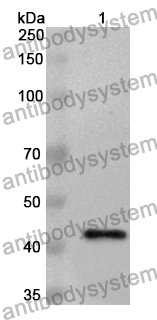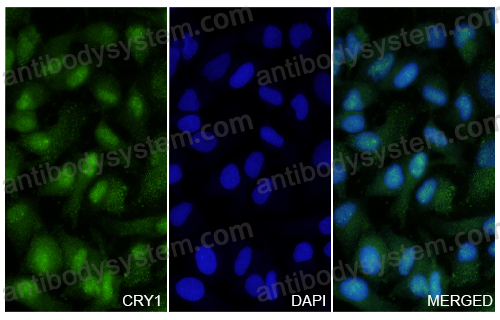Catalog No.
PHH27601
Species reactivity
Human, Mouse, Rat
Host species
Rabbit
Isotype
IgG
Clonality
Polyclonal
Immunogen
E. coli - derived recombinant Human CRY1 (Val3-Leu132).
Tested applications
ELISA: 1:4000-1:8000, IHC: 1:50-1:100, WB: 1:1000-1:4000
Target
Cryptochrome-1,CRY1,PHLL1
Purification
Purified by antigen affinity column.
Accession
Q16526
Applications
ELISA, IHC, WB
Form
Liquid
Storage buffer
0.01M PBS, pH 7.4, 50% Glycerol, 0.05% Proclin 300.
Stability and Storage
Use a manual defrost freezer and avoid repeated freeze thaw cycles. Store at 2 to 8°C for frequent use. Store at -20 to -80°C for twelve months from the date of receipt.
Full-Length Cryptochrome 1 in the Outer Segments of the Retinal Blue Cone Photoreceptors in Humans and Great Apes Suggests a Role Beyond Transcriptional Repression., PMID:40277221
Synergism of Cry1 Toxins by a Fusion Protein Derived from a Cadherin Fragment and an Antibody Peptide., PMID:39189874
Rational design and application of broad-spectrum antibodies for Bt Cry toxins determination., PMID:38843975
Establishment of novel receptor-antibody sandwich assays to broadly detect Bacillus thuringiensis Cry1 and Cry2 toxins., PMID:37972832
Circadian clock disruption in autoimmune thyroiditis., PMID:37548297
Cryptochrome proteins regulate the circadian intracellular behavior and localization of PER2 in mouse suprachiasmatic nucleus neurons., PMID:35046033
Antibodies Against the Clock Proteins Period and Cryptochrome Reveal the Neuronal Organization of the Circadian Clock in the Pea Aphid., PMID:34366893
Screening for single-chain variable fragment antibodies against multiple Cry1 toxins from an immunized mouse phage display antibody library., PMID:29484477
Circadian clock cryptochrome proteins regulate autoimmunity., PMID:29109286
Broad specificity immunoassay for detection of Bacillus thuringiensis Cry toxins through engineering of a single chain variable fragment with mutagenesis and screening., PMID:28939515
Site-saturation mutagenesis library construction and screening for specific broad-spectrum single-domain antibodies against multiple Cry1 toxins., PMID:28601895
Simultaneous production of monoclonal antibodies against Bacillus thuringiensis (Bt) Cry1 toxins using a mixture immunization., PMID:28527908
Cyclic Variation of Cellular Clock Proteins in the Mouse Estrous Ovary., PMID:27920997
Interactive Organization of the Circadian Core Regulators PER2, BMAL1, CLOCK and PML., PMID:27383066
Production and Characterization of Monoclonal Antibody Broadly Recognizing Cry1 Toxins by Use of Designed Polypeptide as Hapten., PMID:27341419
Investigations of immunogenic, allergenic and adjuvant properties of Cry1Ab protein after intragastric exposure in a food allergy model in mice., PMID:27141950
Cryptochrome 1 in Retinal Cone Photoreceptors Suggests a Novel Functional Role in Mammals., PMID:26898837
A high-throughput liquid bead array-based screening technology for Bt presence in GMO manipulation., PMID:26499065
Surrogate molecular markers for IGHV mutational status in chronic lymphocytic leukemia for predicting time to first treatment., PMID:26038121
Role of type II protein arginine methyltransferase 5 in the regulation of Circadian Per1 gene., PMID:23133559
Light-dependent structural change of chicken retinal Cryptochrome4., PMID:23095750
cry1 and GPA1 signaling genetically interact in hook opening and anthocyanin synthesis in Arabidopsis., PMID:22855128
Melatonin attenuates clock gene cryptochrome1, which may aggravate mouse anti-type II collagen antibody-induced arthritis., PMID:21113809
Analysis of chronic lymphotic leukemia transcriptomic profile: differences between molecular subgroups., PMID:19127482
The photopigment melanopsin is exclusively present in pituitary adenylate cyclase-activating polypeptide-containing retinal ganglion cells of the retinohypothalamic tract., PMID:11756521
Probable identification of a membrane-associated repressor of Bacillus subtilis DNA replication as the E2 subunit of the pyruvate dehydrogenase complex., PMID:10735853
Nuclear localization of the Arabidopsis blue light receptor cryptochrome 2., PMID:10476076
Characterization of photolyase/blue-light receptor homologs in mouse and human cells., PMID:9801304
The use of a ribosomal RNA targeted oligonucleotide probe for fluorescent labelling of viable Cryptosporidium parvum oocysts., PMID:9750273


